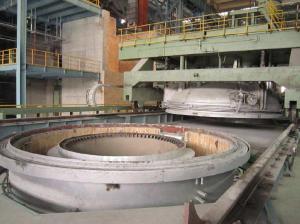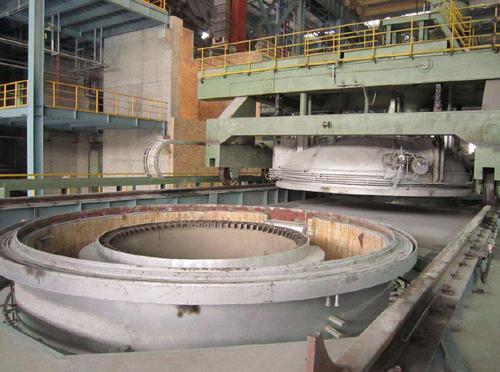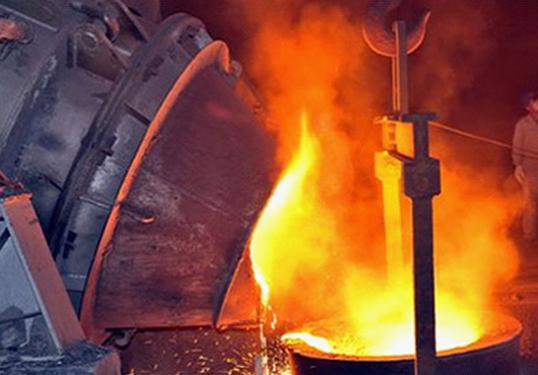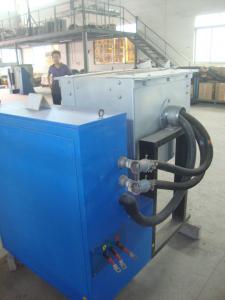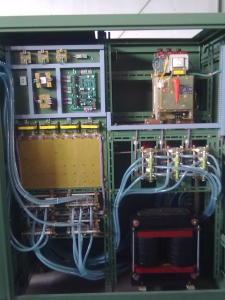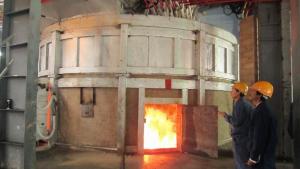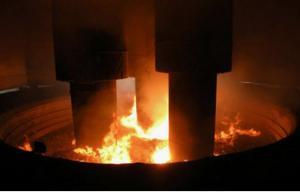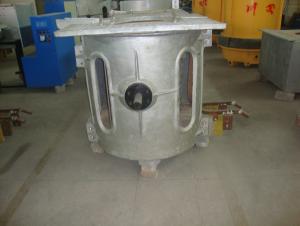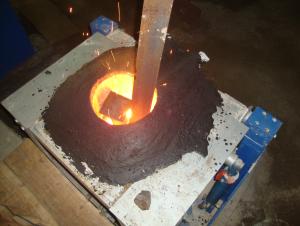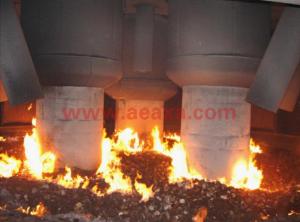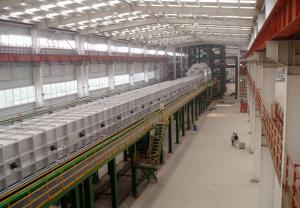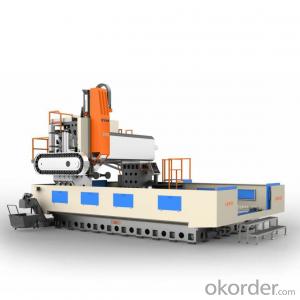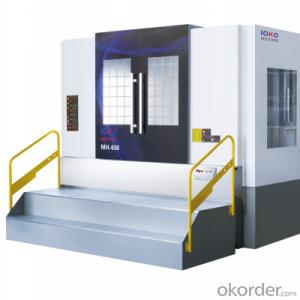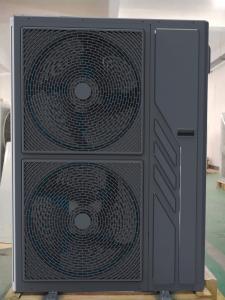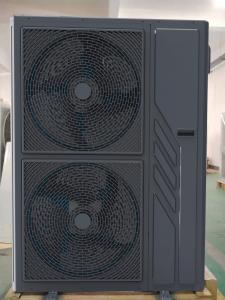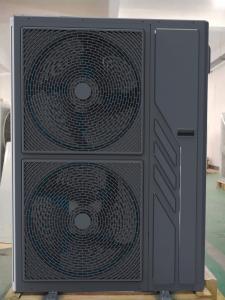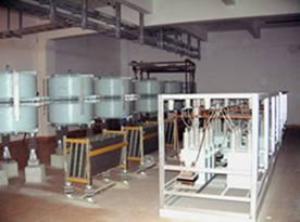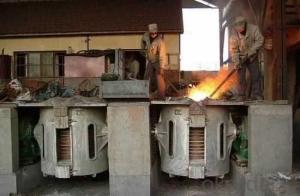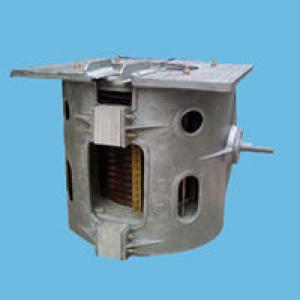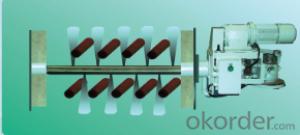Basic Oxygen Furnace (BOF)
- Loading Port:
- China Main Port
- Payment Terms:
- TT OR LC
- Min Order Qty:
- -
- Supply Capability:
- -
OKorder Service Pledge
OKorder Financial Service
You Might Also Like
Basic Oxygen Furnace (BOF)
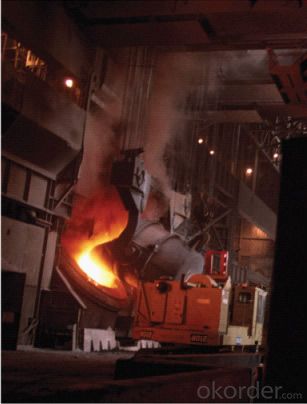
Top Blown Process (BOP)
In the top blown process a water cooled oxygen lance is lowered from the top of the furnace and blows oxygen at supersonic speed into the melt. The majority steelmakers utilize top-blown oxygen steelmaking.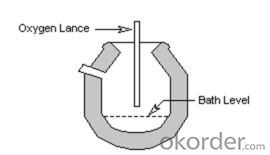
Bottom Blown Furnace (Q-BOP)
In the bottom-blown processes, oxygen is introduced through a number of tuyeres in the bottom of the furnace. In the Q-BOP process, the oxygen tuyeres are cooled by injecting hydrocarbon gas through an outer pipe surrounding the oxygen pipe. Most bottom-blown processes use methane or propane as the hydrocarbon coolant, but fuel oil is also used. A principle advantage of the Q-BOP process is that it reduces the height requirements of the process allowing a lower profile building to be constructed.
Combination Processes
One class of combination blown process uses top-blown oxygen with inert gas (argon and Nitrogen) injection through the bottom by means of tuyeres or permeable elements. In the second class of combination furnaces, there are both top and bottom oxygen lances; the bottom lances can also be used for inert gas injection during stirring.
The basic oxygen furnace (BOF), whose profile is shown in the figure, is a tiltable vessel lined with refractories such as magnesia carbon brick. Auxiliary equipment includes a chute for scrap charging, hoppers for alloys and fluxes, a lance for injecting pure oxygen gas, a sublance for measuring the temperature and carbon concentration of the molten steel, lifting devices for the lance and sublance, equipment for tilting the vessel, and equipment for recovering and cleaning the exhaust gas. The BOF capacity is expressed as the weight of crude steel that can be decarburized per heat. Most BOFs in China have a capacity of 150-300 tons.
The main function of the BOF is to decarburize the hot metal using pure oxygen gas. In the top-blown BOF, pure oxygen is injected as a high-velocity jet against the surface of the hot metal, allowing penetration of the impinging jet to some depth into the metal bath. Under these conditions, the oxygen reacts directly with carbon in the hot metal to produce carbon monoxide. The pure oxygen top-blown BOF can decarburize 200 tons of hot metal from 4.3% C to 0.04% C during 20 minutes. As a result of this high productivity, the BOF replaced the open hearth furnace, which was a much slower process.
The injected pure oxygen gas first oxidizes silicon and then carbon in hot metal. When the carbon concentration of the hot metal is decreased to about 1%, the oxidation of Iron begins in parallel with that of carbon. The oxidation of Iron becomes marked at carbon concentrations of less than 0.1%, decreasing both the oxygen efficiency for decarburization and the decarburization rate, while increasing Iron loss into the slag. The problem with the top-blown BOF is thus the oxidation of Iron when a low carbon concentration is reached, and the resulting decrease in the decarburization rate. When the Iron oxide content of the slag increases excessively, it can react too quickly with carbon in the molten Steel and cause sudden gas evolution, forming a mix of slag and molten Steel that sometimes erupts from the vessel in a phenomenon called "slopping" or "spitting".
The use of an oxygen lance with multiple holes at the tip has proven very effective in delocalizing the oxygen supply and increasing the decarburization rate while restraining excessive oxidation of the molten Steel and preventing slopping and spitting. However, the effectiveness of this lance was still inadequate, and the bottom-blown oxygen process was developed, in which pure oxygen gas is injected into the molten Steel from the bottom of the BOF. The bottom blowing enhances the stirring of the hot metal and thereby shortens the average mixing time in the molten Steel bath, and promotes transport of solute carbon in the bath, preventing the over-oxidation of slag, which is the cause of slopping and spitting. Consequently, the bottom blowing enhances decarburization efficiency, especially at low carbon concentrations. The bottom-blowing is performed with bottom tuyeres of concentric double-wall pipe. The inner pipe is used to blow pure oxygen gas along with pulverized limestone as a slag-forming agent, while propane gas is blown through the outer pipe as a coolant to prevent tuyere burn back, since propane undergoes an endothermic reaction during decomposition, which results in cooling and reduced burning of the tuyeres. These improvements have made the production of low-carbon steels much easier.
The top-and-bottom blown BOF, which combines the advantages of both types of BOF, has recently become prominent in oxygen steel making. The combined blowing BOF mostly uses bottom-blown inert gases in place of oxygen gas for stirring. Various methods of bottom-blowing have been adopted. As one example, a ceramic plug with embedded multiple small pipes or multiple slits is used in the bottom tuyeres. Irrespective of the type of the BOF, the exhaust gas, which is high in CO content, is either combusted in the throat of the BOF and passes through a waste-heat boiler installed in the upper part of the throat to recover the sensible heat and the heat of combustion, or is recovered through exhaust-gas recovery equipment and stored in a gas tank for later use as fuel.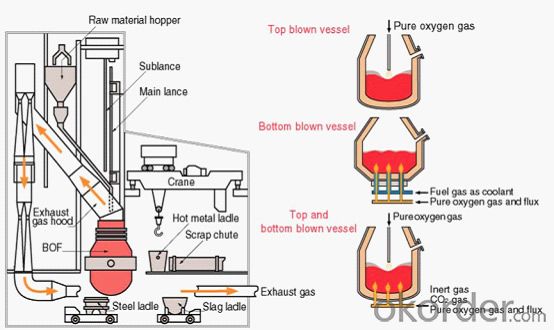
- Q:What is the difference in structure between industrial furnace and boiler?
- At the same time, the working environment is relatively poor, the structure should be sturdy and durable, the transfer mechanism (generally) to stable and durable low failure rate, the insulation layer must be thick enough and the economy, the steel structure housing materials used to be enough.
- Q:What are the advantages of a vacuum furnace?
- The accuracy of furnace temperature measurement and monitoring is obviously improved. The indicating temperature of the thermocouple and the temperature of the furnace reach 1.5 C. But there is a large temperature difference in a large number of workpieces in different parts of the furnace. If the forced circulation of the rarefied gas is adopted, the temperature range of the temperature range of + 5 DEG C can still be controlled.
- Q:What's the role of anchor bricks in industrial furnaces?
- These layers need to be joined and anchored. Anchor brick is this role. The heat insulation layer at the horizontal section of the flue is mostly a narrow cavity.
- Q:Selection of heat preservation material for industrial furnace
- Micro nano heat insulation board.The thermal conductivity of micro nano heat insulation board is very low, only a fraction of the traditional thermal insulation material, and the insulation effect is very efficient.
- Q:Why does the burner of industrial furnace burn occasionally?
- The basic structure of the complete ignition system is the ignition device and flameout protection device. The ignition burner includes an ignition electrode and an igniter (equipped with some external type transformer, voltage transformer) through the above 10kV, the ignition electrode spark ignition of high voltage discharge to ignite gas column.
- Q:What is an industrial furnace pit?
- Later, a chamber kiln with a semi closed or fully enclosed kiln made of refractory bricks can be used as fuel for coal, gas or oil, and electricity can be used as heat source. The workpiece will be heated in the kiln hearth.
- Q:What is the difference between industrial furnace masonry and ordinary masonry?
- Of course, the difference is like the difference between a hog cap and a 100 story building. See the industrial furnace manual.
- Q:What are the companies in the world that are currently engaged in metallurgical furnaces?
- Each manufacturer has its own industry and technological advantages.If you say that the performance rankings, turnover, and so on, it seems that no one has done this ranking.
- Q:How to use industrial furnace equipment?
- The protection device of the exposed transmission department shall be installed with the correct installation position. The structure is reasonable. The wire rope pulley of the furnace car shall be intact and undamaged. All the pulleys and sprockets on the furnace are in good condition, without defects and flexible in rolling.
- Q:What are the combustion equipments used in industrial boilers?
- The main auxiliary equipments of the general boiler are: upper coal machine, ash blower, blower, draught fan, economizer, feed pump and water treatment unit. Oil boilers are: oil pumps, burners, tanks and so on.
1. Manufacturer Overview |
|
|---|---|
| Location | |
| Year Established | |
| Annual Output Value | |
| Main Markets | |
| Company Certifications | |
2. Manufacturer Certificates |
|
|---|---|
| a) Certification Name | |
| Range | |
| Reference | |
| Validity Period | |
3. Manufacturer Capability |
|
|---|---|
| a)Trade Capacity | |
| Nearest Port | |
| Export Percentage | |
| No.of Employees in Trade Department | |
| Language Spoken: | |
| b)Factory Information | |
| Factory Size: | |
| No. of Production Lines | |
| Contract Manufacturing | |
| Product Price Range | |
Send your message to us
Basic Oxygen Furnace (BOF)
- Loading Port:
- China Main Port
- Payment Terms:
- TT OR LC
- Min Order Qty:
- -
- Supply Capability:
- -
OKorder Service Pledge
OKorder Financial Service
Similar products
New products
Hot products
Hot Searches
Related keywords
